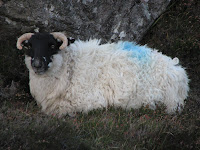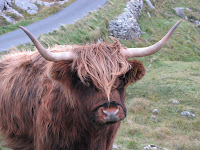Headed off from Grassington through Newcastle to Galashiels along the local roads. We saw signs for 'Free WIFI' in Jedburgh so pulled into the council car park there and used our SKYPE to call our friends Craig and Cheryl Wilkinson who work in Gorebridge. It was difficult to find a phone box that would take coins, or a shop that sold cards for the card phones to call them so we were delighted to get a free connection.
We arrived in the dark and managed to get some supplies at the local Coop supermarket while we waited for Cheryl to escort us back to their place.

Rosebery House
Craig and Cheryl are both working on Rosebery Estate, she as a housekeeper and he as a driver and doer of all other jobs that need doing. They live across the road from Lord and Lady Dalmenys' house in a comfortable warm and cosy staff house.

It is becoming more and more common for New Zealanders, and probably others too, to work as housekeepers if they can get ancestral visas. It is particularly popular for those who are having a mid life crisis or whose children are now independent. Craig and Cheryl fall into the latter.
While chatting about Rosebery Estates, we learnt that one of the Earls of Rosebery had married Hannah, the only daughter of the Rothschilds, and they inherited the Rothschild wealth. A lot of these art treasures are now owned by the present Lord Rosebery and family.

The next day Cheryl and John played golf at the Dalmeny House golf course, near Queensferry, just outside Edinburgh.

The weather stayed fine enough to enjoy a couple of rounds on the 9 hole course which is for staff only. Dalmeny is a part of the Rosebery Estates as well.


Dalmeny House
Craig couldn't join us as he had to pick up his boss, Lord Dalmeny, at Balmoral Castle where he had been shooting with the Queen. Craig mentioned that John's grandparents had worked at Mentmore House and Lord Dalmeny told him to ring the housekeeper at Dalmeny House and ask to be shown the art treasures from Mentmore.
The next day Craig and John played golf at Dalmeny and then we were able to visit some of the rooms in Dalmeny House. The sign at the front said the rooms were closed to the public for all of 2008 so we were lucky enough to have a look around. There was a Gothic Hall with a chest that Captain Cook owned along with a whale harpoon. We could also see the Napoleon Room, the Rothschild Room, and the Mentmore Room. The only Goya tapestries outside Spain were hanging on the hall walls.
Interestingly, Craig and Cheryl's boss is an auctioneer for Sothebys and was responsible for auctioning the art work for Damian Hirst for 111million pounds.
We couldn't believe that there would be so many connections to John and his grandparents!



















































